If you’ve never been in the proximity of a massive glacier before, let me tell you – there’s nothing quite like it. The perfect-blue streams of water making their way from this wall of ice, rushing down rocky slopes of rubble that have been carved up by the retreating behemoth… the glacier itself is only one part of the experience – the strangely barren cliffs all around you exhibiting the glacier’s effect on the landscape is what makes it feel like you’re truly somewhere unique. This short walk up to the toe of the Athabasca Glacier is located in the Columbia Icefield, the largest icefield in the Rocky Mountains.
Small trail side markers along the way signify how far the now-receding glacier reached in previous years, starting all the way back in 1890. Some models suggest that the dying glacier will disappear completely between 2040 and 2100, along with 90% of Alberta’s glaciers at the end of the century.
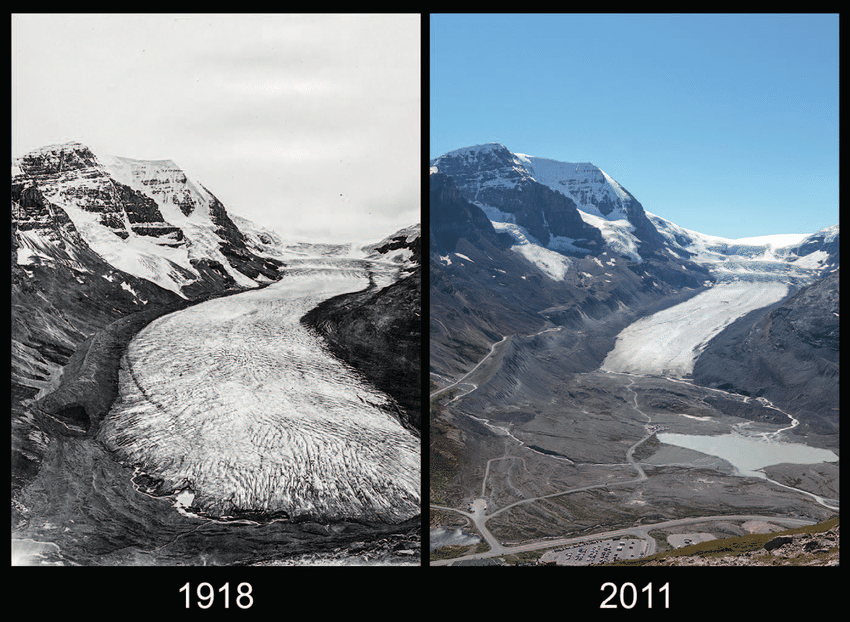
If you’re looking for a tourist-free rugged wilderness experience, sorry but this is not it. The Athabasca Glacier is probably the most commercially developed area of The Icefields Parkway. That said, if you’ve never been up near a glacier before is this an experience worth having? Absolutely. A short straightforward walk is all takes to get up to the rocky plateau looking out at the glacier. Further travel is roped off and signs ask that you go no further. If you’re driving up the Icefields Parkway, visiting this glacier is definitely an essential must-do on your Icefields Parkway itinerary.
Continue reading this blog post for everything you need to know to experience the Athabasca Glacier in Jasper for yourself, including distance, elevation gain, how to get there, the best time to visit, and lots of photos of my experience.
Note: The Athabasca Glacier is located in Jasper National Park, meaning that a valid park pass is required. Day passes can be purchased at the park gates and are per day per person, but if you’re staying a week or longer, it’s more cost-effective to just buy an annual pass instead.
Before visiting Jasper National Park it’s essential to read up on the Parks Canada rules that must be followed to avoid tickets and/or fines. When hiking it’s important to avoid harmful practices such as disturbing plants or rock-stacking, or removing any natural object from flowers to rocks, as it’s important to leave the environment as natural as possible for the animals and for fellow hikers to enjoy in perpetuity. As many flowers as there are, there are few enough that if we all took one, then there wouldn’t be any left. If you’re after a souvenir to take home with you, there are tons of gift shops in the Jasper townsite to check out. Otherwise take only photos, leave only footprints. I’ve seen lots people stealing rocks as souvenirs from near the Athabasca Glacier, and unfortunately due to trying to keep this blog family friendly I can’t use the words I’d like to describe these kinds of people.
If you haven’t heard of Leave No Trace principles, they’re also really essential to read up on before heading anywhere into the outdoors in general. Following these important principles basically means doing your best to leave beautiful places like the Athabasca Glacier as good (if not better) than you found them, both for their preservation and for the enjoyment of other visitors.
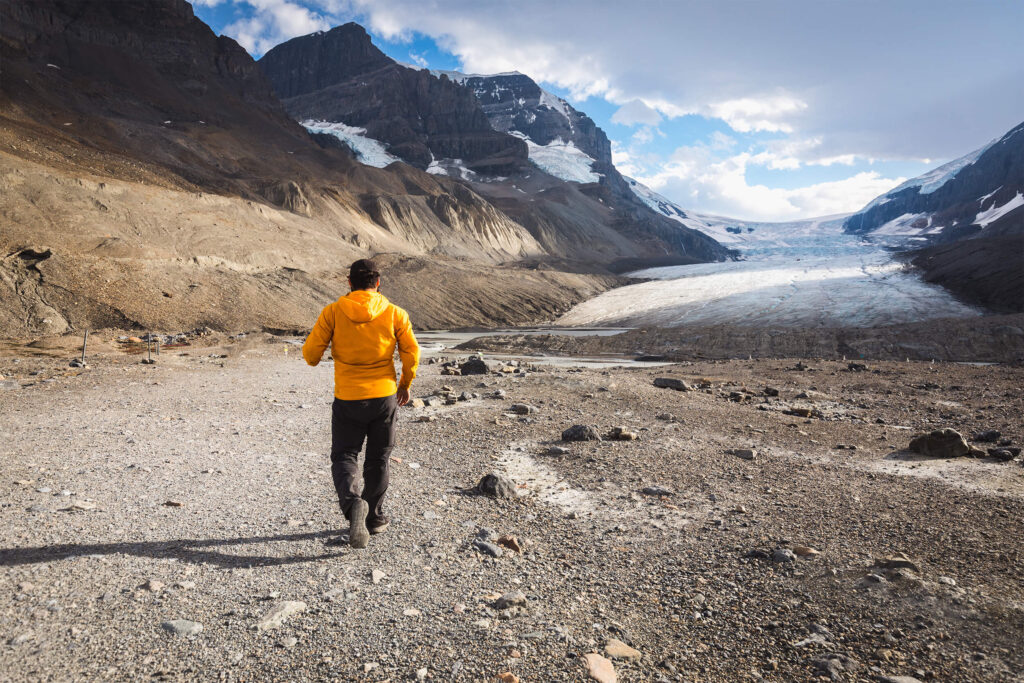
Athabasca Glacier Round Trip Details
Distance: 1.4 KM / 0.8 MI
Elevation Gain: 60 M / 196 FT
Hiking Time: 20 Mins
Hiking & Safety Tips
- Prepare for the possibility of wildlife encounters. Bear spray is a must whenever travelling in bear country, as well as learning how to use it. Though your chance of an aggressive bear encounter is low, it is always better to be prepared with bear spray. Bear bells are proven to be an ineffective bear deterrent, and are actively discouraged by Parks Canada. The best way to let bears know you’re around is simply to use your voice. Make sure to keep a respectful distance from wildlife and never feed the animals. It may seem kind but it doesn’t just kill wildlife and put people in danger, it’s also illegal.
- Research current trail conditions and make sure you are well-informed about the route before you leave, and assess if it is within your capability. Be aware of what time it gets dark and check the weather forecast. Make sure to tell someone where you’re going and when you expect to return. Every year as more and more people try hiking for the first time, the number of rescues goes up. Being prepared is the best defense.
- Pack everything you need for a successful hike, including enough water and energy-rich snacks. Remember to pack out everything you pack in though – don’t expect to find a convenient garbage can halfway up the trail. Bring appropriate layers (remember you’ll warm up once you start hiking) and sun protection. Hiking poles may be helpful but are not required. In addition to not leaving any garbage on the trail yourself, I highly recommend bringing a garbage bag and collecting any trash that you do see on the trail. You’re guaranteed to make the walk to the Athabasca Glacier a more enjoyable experience for the next person.
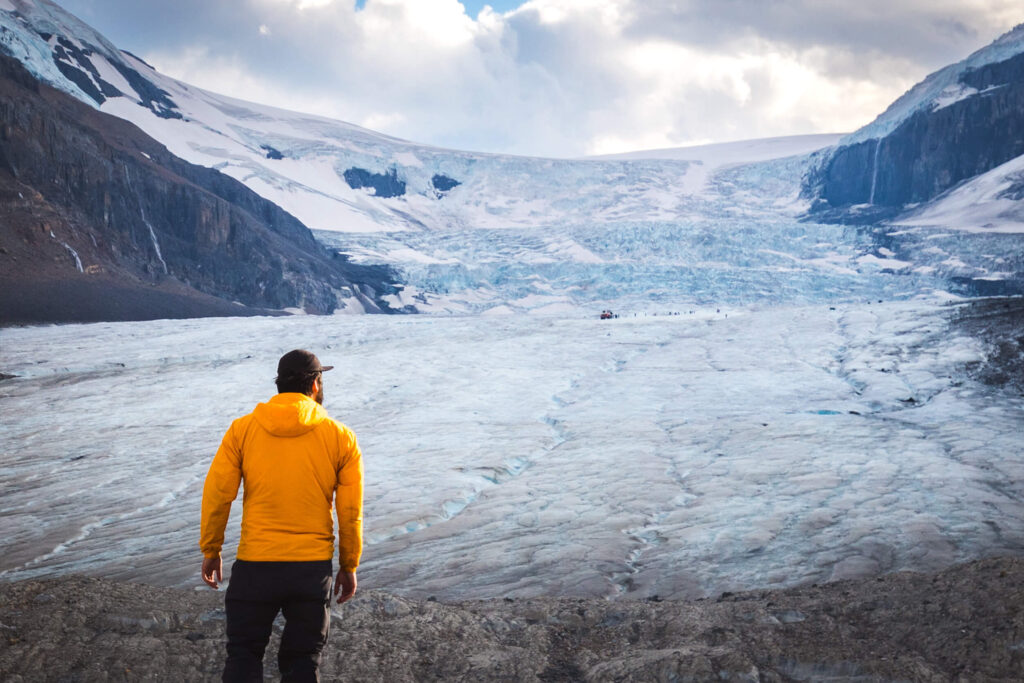
How to Get to Athabasca Glacier Trailhead
The Athabasca Glacier is just one of many beautiful stops along the world-famous Icefields Parkway. When approaching the Columbia Icefield, in which the Athabasca Glacier resides, one of the first things you will notice (after the glaciers themselves) is the large visitor’s center on the east side of the road. Turn off here if you’re craving Starbucks. Alternatively, turn the opposite direction down a rough and bumpy road if you’d like to walk up to the Athabasca Glacier, just near the large Sunwapta Lake. The trailhead is two hours from Banff, or just over an hour from Jasper.
Click here to open the exact trailhead location in Google Maps.
Walking to the Athabasca Glacier
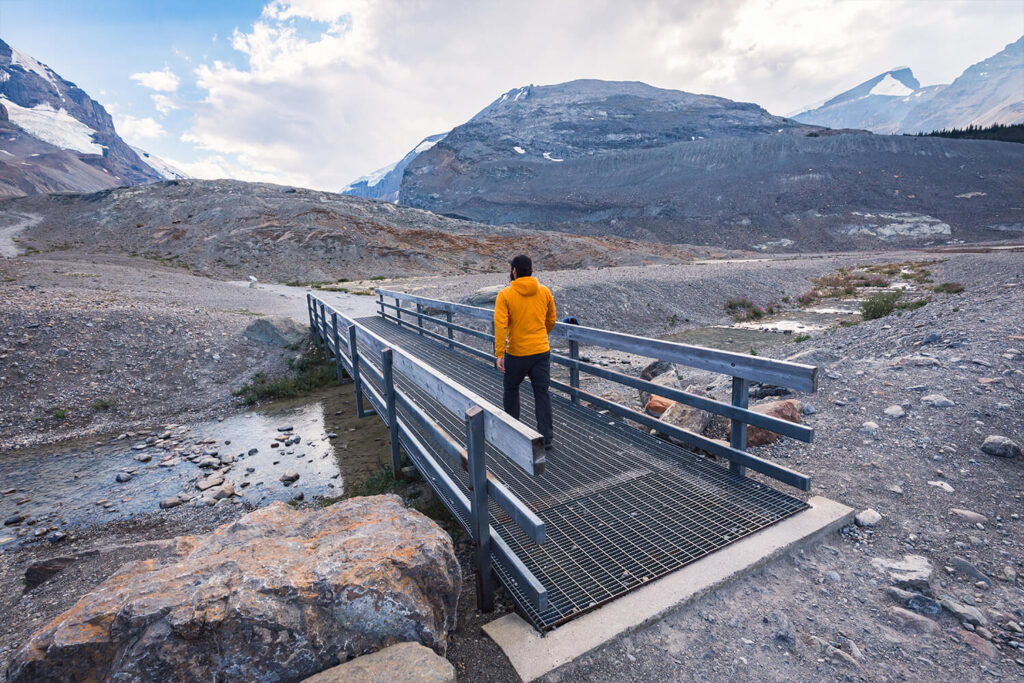
Setting off from the rugged parking lot towards the Athabasca Glacier.
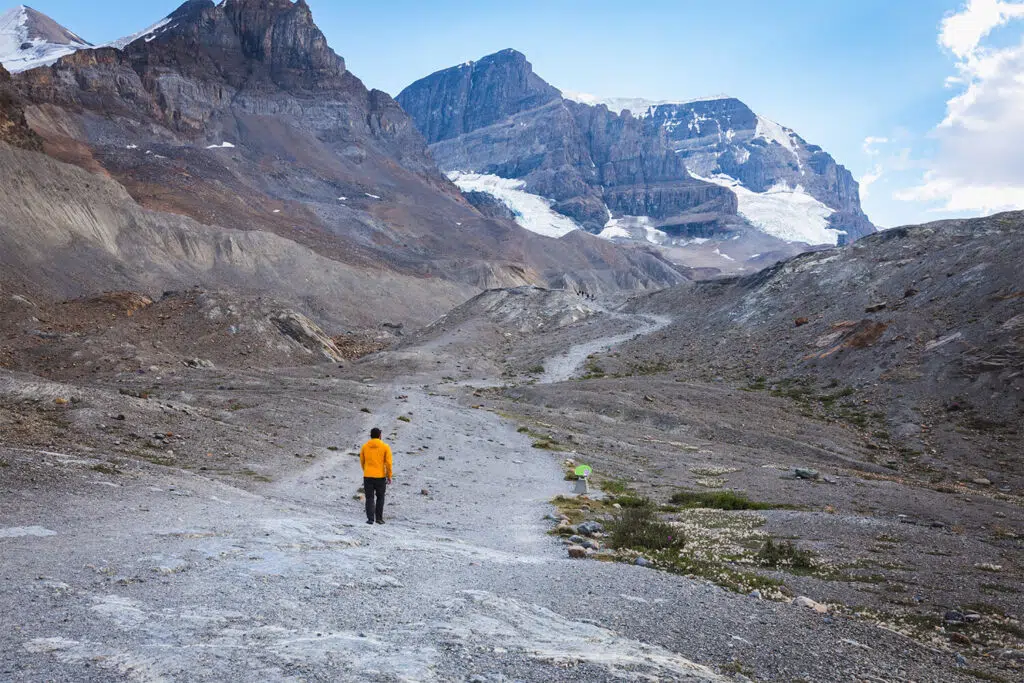
No false summits – the trail meanders up this hill and then you’re there.
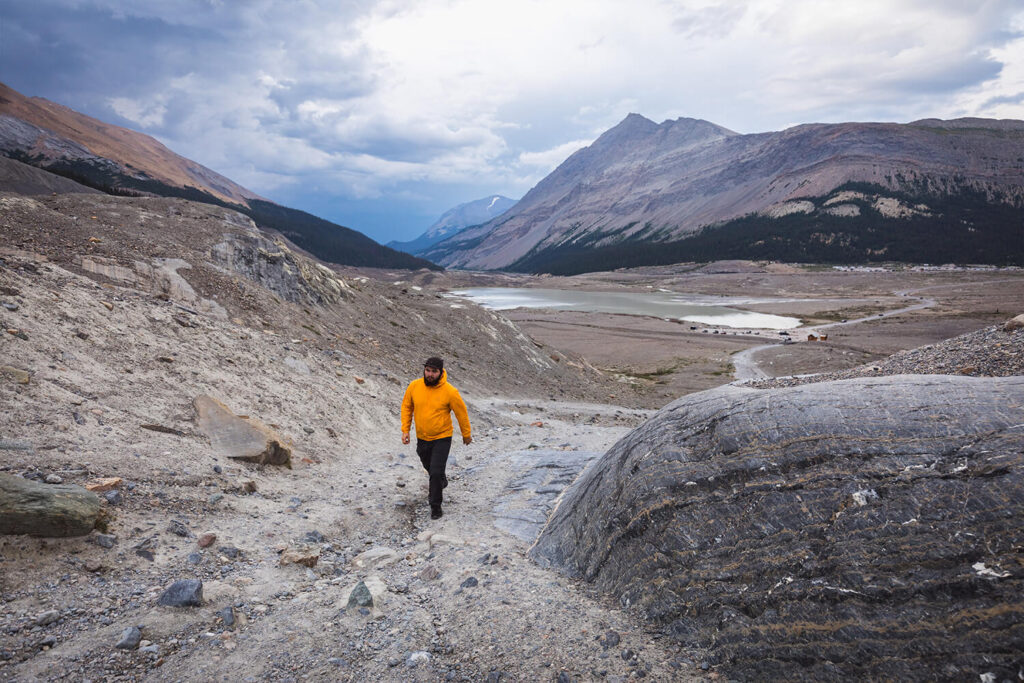
Glscier-fed Sunwapta Lake to the rear looking somewhat gloomy. In the right light conditions it can be a much more brilliant blue.
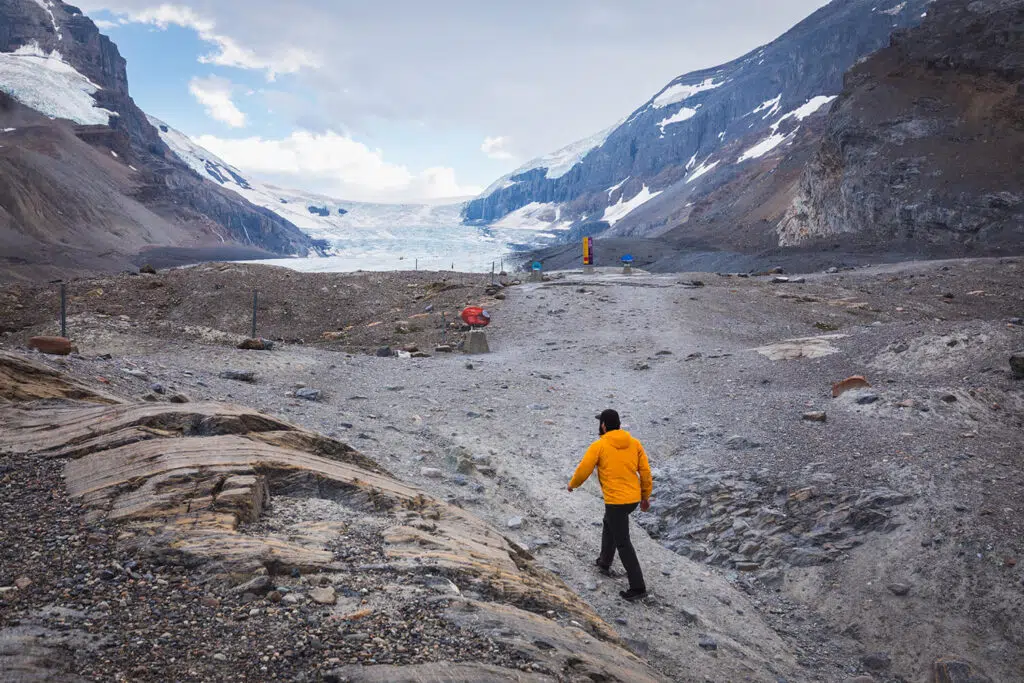
Near the top. Informative panels describe the slow retreat of the glacier. Cold winds from the direction of the glacier make their appearance here.
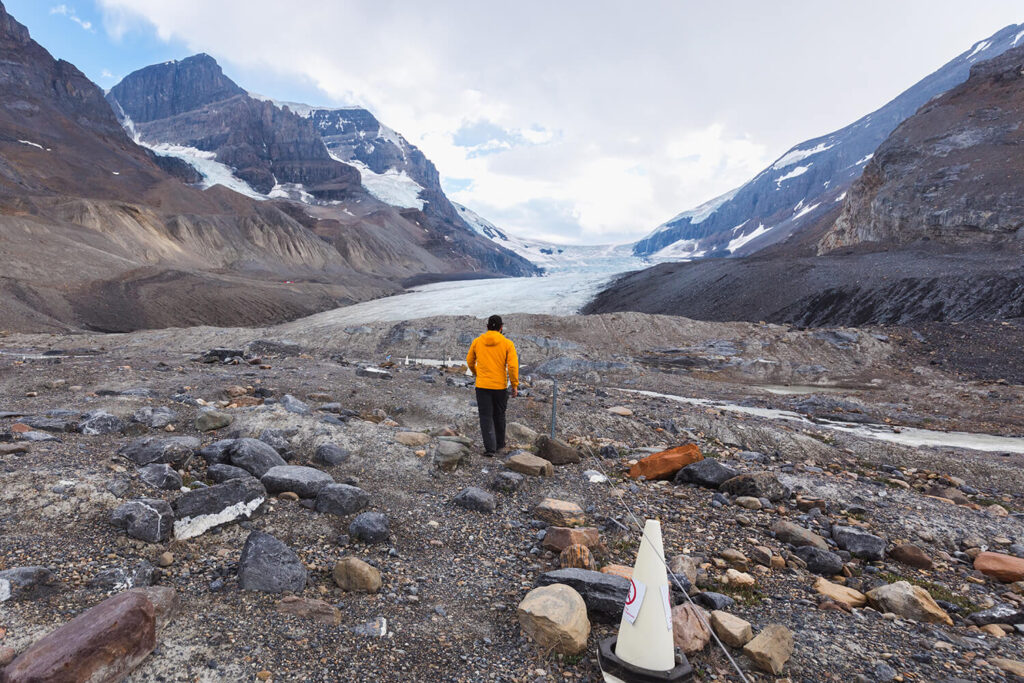
Sadly a boundary limits people from approaching the glacier itself, however the views from here are impressive nonetheless.
Recommended Hiking Gear



Water is a must whenever I’m hiking, especially if the sun is going to be out. My favourite water filter I’ve used is the Katadyn BeFree 0.6L, which unlike other water filters I’ve used packs up really small and lightweight. For hikes where I know there won’t be any readily available water sources along the way, I make sure to bring my own. The Hydrapak Stow 1L bottle is my go-to, for the same reason that it’s made of a soft plastic that folds up and doesn’t take up any more extra space than necessary in my pack. Finally, Aquatabs are another great option for purifying water, with one tablet being suitable for one litre of water. I previously used the Grayl water filter while travelling internationally, and though I found its hard body more convenient for day to day use and easier to drink from, it has a little too much bulk for my fast-and-light style of hiking.



The secret to all my photos of gorgeous sunset and sunrise mountaintop views? A lot of hiking in the dark. And let me speak from personal experience when I say that the last thing that you want to happen when hiking is to be caught in the dark without a headlamp. I used the Black Diamond Spot 400 for years and it worked great – until I lost it on top of a mountain somewhere. The only downside to it was having to worry about the batteries dying, though there’s also a slightly more expensive version that has a rechargeable battery. Nowadays I’m using the Petzl Actik Core, which is a bit pricier than the more budget-friendly Black Diamond, but is also brighter, more comfortable (in my opinion), and has a hybrid power system that is rechargeable but can also take AAA batteries if needed.
You won’t see me using trekking poles on shorter hikes often – but on long hikes and backpacking trips, as well as certain scrambles, they are an absolute lifesaver. I’ve invested in a high quality ultra-lightweight pair of MSR DynaLock Ascent carbon poles which, while pricey, I don’t regret one bit. If you’re not entirely sure how much use you’re going to get out of a pair of trekking poles, the best budget-friendly option would be the Trekology Trek Z 2.0. Amazon does sell a lot of cheaper Made in China-style trekking poles for cheaper, but these usually are much much heavier and not worth buying.
All the best and most long-lasting cables and power banks I’ve ever owned have been Anker. I once had a phone cable from them that lasted me over three years of daily use! That’s why I keep an Anker PowerCore Essential 20K power bank on me. Like many people I use my phone for a lot of stuff when hiking (checking in with family, using online maps, taking photos, flying my drone) so I like to be prepared for that low battery warning by having a backup power source on me just in case.



The only socks I ever buy for myself are from Darn Tough, and I almost always make sure to wear them when hiking. After years of having no problems only wearing these comfortable and rugged socks for hikes, I accidentally wore a pair of no-name socks on a hike last year and ended up with blisters on both feet. Safe to say I’m back to sticking with the Darn Tough. And the best part? They have a lifetime guarantee, meaning that if they ever wear out you can send them back for a brand new pair. For hiking footwear I go between a pair of lightweight approach shoes for quick and dirty mountain ascents or anything involving scrambling and more heavy-duty boots for longer treks. I’ve worn a couple different versions of the lightweight but super durable Arc’teryx Konseal FL 2 approach shoes for a few years now and am very impressed with the durability. I also really like the thick toecap that keeps me protected every time I stumble into a root or large rock. For longer, tougher, or muddier treks I rely on my LOWA Camino EVO GTX, which I find insanely comfortable and made of very high quality.



I wear my Ar’teryx Gamma Lightweight Pants on every single hike I go on, and on many days when I’m not hiking. After several years of abuse they are still holding together extraordinarily well, with only a few small holes from where I’ve fallen down and some slight stains from being repeatedly coated with mud. They’re lightweight, breathable, and super comfortable. For lightweight and breathable hiking tops I’m a big fan of both the Patagonia Capilene Shirt and the MEC Core Shirt. My Arc’teryx Squamish Hoody shows up in a lot of my photos. It’s super lightweight and packable, and does a great job of cutting the wind while also being pretty breathable. I also have an Arc’teryx Atom Hoody and Arc’teryx Beta LT that I pull out for cooler or wetter conditions.
I hope you enjoyed this guide to hiking to the Athabasca Glacier in Jasper National Park! Feel free to leave any questions in the comment section below or to contact me directly via social media.
